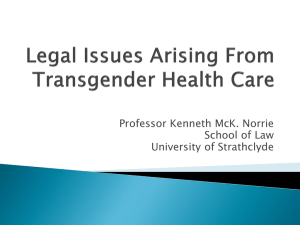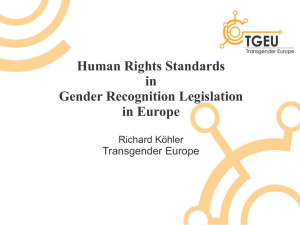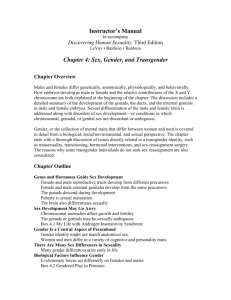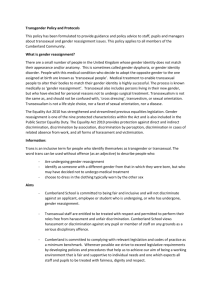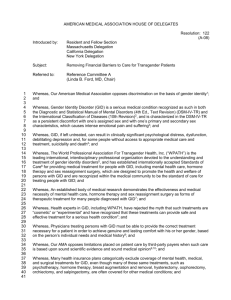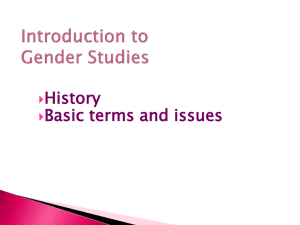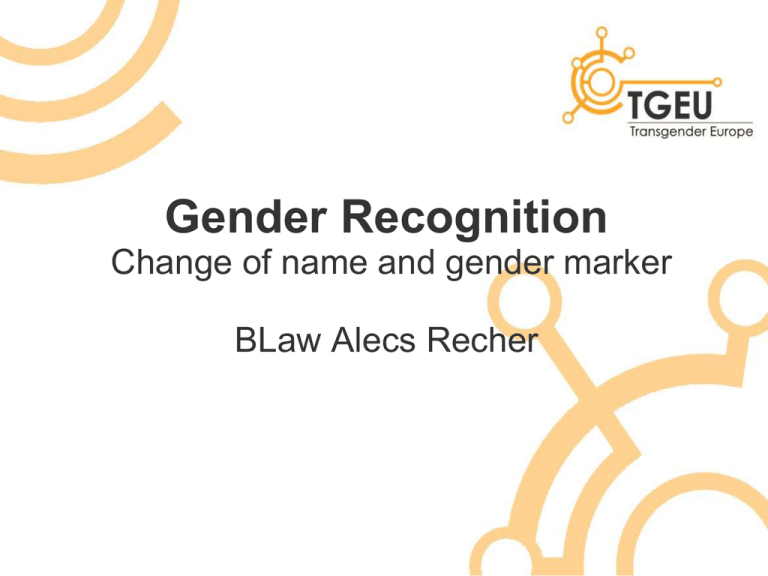
Gender Recognition
Change of name and gender marker
BLaw Alecs Recher
Name&Gender =
Entry to Society
Without name and gender recognition trans
people are marked as transgender:
ID cards, credit and bank cards
School and University degrees
Leads to stigmatization in every aspect of life
like exclusion from traveling, labour market,
participation in social life
Name&Gender =
Entry to Society
Legally speaking:
Gender identity: specially sensitive aspect of
private life
Positive obligation to gender recognition is a
fundamental right
+
Conditions and procedure have to be in
accordance with fundamental rights
Key problems
unreasonable conditions to change name and
gender
Sterilization / permanent infertility
Sex reassignment surgery
Divorce
Violates basic human rights
Physical integrity (UDHR Art. 5)
Choice of medical interventions
Protection of the marital union, rights of the
partner and evt. children
European Court of Human
Rights
Individual complaints, binding
Minimal standard for the 47 member states of the
Council of Europe
European Court of Human
Rights
Goodwin & I. (Application no. 28957/95, 2002):
- positive obligation to full gender recognition
post-operative, incl. birth certificate
- States margin of appreciation to define the
requirements
- Right to marry according to the legal gender
- “Convention is interpreted and applied in a
manner which renders its rights practical and
effective, not theoretical and illusory.”
European Court of Human
Rights
Developments in non-legal fields have to be
taken into account:
“this Court has since 1986 emphasised the
importance of keeping the need for appropriate
legal measures under review having regard to
scientific and societal developments”
Goodwin Judgment, § 92
> Recent developments like WPATH Standards
of Care 7?
European Court of Human
Rights
L. v. Lithuania (Application no. 27527/03, 2007):
Fulfiling conditions set by the state must be
possible within the respective State
Council of Europe
Committee of Ministers Recommendation
(2010)5, §§ 20-22
Soft law, no individual complaints, political
statement
20. “Prior requirements, including changes of a
physical nature, for legal recognition of a
gender reassignment, should be regularly
reviewed in order to remove abusive
requirements.”
Council of Europe
“In some countries access to gender reassignment services
is conditional upon procedures such as irreversible
sterilisation, hormonal treatment, preliminary surgical
procedures and sometimes also proof of the person’s
ability to live for a long period of time in the new gender
(the so called “real life experience”). In this respect,
existing requirements and procedures should be
reviewed in order to remove those requirements which
are disproportionate. It should be noted, in particular,
that for some persons it may not possible, for health
reasons, to complete every hormonal and/or surgical step
required.” Explanatory memorandum
Council of Europe
21. “(...) guarantee the full legal recognition of a
person’s gender reassignment in all areas of
life, in particular by making possible the change
of name and gender in official documents in a
quick, transparent and accessible way (...)
corresponding recognition and changes by nonstate actors with respect to key documents”
> Obligation not limited to state actors!
Council of Europe
22. “(...) ensure that, once gender reassignment
has been completed and legally recognised (...)
the right of transgender persons to marry a
person of the sex opposite to their reassigned
sex is effectively guaranteed.”
> Same as Goodwin judgment
Council of Europe
Discrimination on the basis of sexual orientation
and gender identity (“Gross Report”), Doc.
12185, 2010, adopted by the Parliamentary
Assembly
“Transgender people are refused gender
reassignment treatment or told they cannot
register their new gender, contributing to high
rates of suicide in this group.
These human rights violations must end”
Council of Europe
4. “Abolish sterilisation and other compulsory
medical treatment as a necessary legal
requirement to recognise a person’s gender
identity in laws regulating the process for name
and sex change”
Council of Europe
Commissioner for Human Rights
Hammarberg, Thomas: Issue Paper 2009
Moral authority
3. “Develop expeditious and transparent
procedures for changing the name and sex of
a transgender person on birth certificates,
identity cards, passports, educational
certificates and other similar documents;”
Council of Europe
6. “Remove any restrictions on the right of
transgender persons to remain in an existing
marriage following a recognised change of
gender”
European Union
No mandate on legal gender recognition
> No binding instruments
EU Parliament Resolution of 28 September
2011 on human rights, sexual orientation and
gender identity at the United Nations
Political statement, not binding
13.”(…) for changing identity to be simplified
(…)”
United Nations
No individual complaints, dialogue among
member states
United Nations
CEDAW (Convention on the Elimination of All
Forms of Discrimination against Women):
“The Committee also expresses concern at
specific health problems experienced by
transgender women, in particular the
compulsory sterilization they should
undergo to get their birth certificates
changed” Concl. Obs., Netherlands,
CEDAW/C/NLD/CO/5, 5. Februar 2010, § 46
Yogyakarta Principles
Translation of UN Charter on LGBTI; moral
authority
3 “No one shall be forced to undergo medical
procedures, including sex reassignment
surgery, sterilisation or hormonal therapy, as a
requirement for legal recognition of their gender
identity. No status, such as marriage or
parenthood, may be invoked as such to
prevent the legal recognition of a person’s
gender identity”
Yogyakarta Principles
B. “Take all necessary legislative, administrative
and other measures to fully respect and legally
recognise each person’s self-defined gender
identity”
C. “(…) all State-issued identity papers which
indicate a person’s gender/sex (…) reflect the
person’s profound self-defined gender identity”
Yogyakarta Principles
D. “Ensure that such procedures are efficient,
fair and non-discriminatory, and respect the
dignity and privacy of the person concerned”
E. “Ensure that changes to identity documents
will be recognised in all contexts where the
identification or dissaggregation of persons by
gender is required by law or policy”
Yogyakarta Principles
6 F. “Ensure the right of all persons ordinarily to
choose when, to whom and how to disclose
information pertaining to their (…) gender
identity, and protect all persons from
arbitrary or unwanted disclosure, or threat of
disclosure of such information by others”
Examples: Common Law
UK and Ireland
change of name by deed poll or written
declaration
Short and inexpensive procedure, starting by 510 £
No evidence requirement for change of name and
title
But: change of birth certificate under Gender
Recognition Act (2004)
Examples: Portugal
Lei n.º 7/2011 from 15 March 2011
request, incl. medical diagnosis “gender
identity disorder” edited by a multidisciplinary
team
at any civil registry administration
decision within 8 days
Examples: Germany
Law from 1980 “Transsexuellen-Gesetz”
Case Law, key conditions declared
unconstitutional:
No minimal age of 25
Applicable to non-german citizens
No more forced divorce
No more forced surgery
Government must revise the law – but hasn’t
done so far
Examples: Austria
No more specific law
Case law
No forced divorce: VfGH (Const. Court)
V4/06, 8 June 2006
“changing a sex entry in a birth certificate
cannot be hindered by marriage”
“It seems that the same-sex marriage of the
former spouses, as a result of one‘s gender
reassignment, cannot be hindered by denying
the change in the birth registry.“
Examples: Austria
No requirements for surgery: VfGH (Const.
Court) 03.12.2009, B 1973/08 and VwGH
(Admin. Court) 27.02.2009, 2008/17/0054
- Relevant is gender identity („psychological
feeling of belonging to the other gender“)
- This feeling will most likely not change anymore
and must be expressed by a clearly visible
harmonisation with the expression of the
opposite gender
Examples: Precedences
Italy
Specific law from 1982 requires sterilization
Tribunale di Roma Judgment no. 5896/2011
from 11.3.2011
For the 2nd time after a precedent in 1997:
change of gender marker w/o demanding
GRS
Examples: Precedences
Switzerland
No specific law, courts demand sterilisation
High Court Canton Zurich, Judgment no.
NC090012/U from 1.2.2011
Sterilisation still required, but
Reversible sterilisation caused by hormonal
treatment sufficient
Forced surgery violates basic rights
Case-Studies
...and now it is your turn!
Case discussion (20‘)
Are there discriminatory aspects in this case?
If yes, what are they?
Which legal tools could be used?
Case I
Civil Code Art. 17: The government of the applicant’s County of Residence may grant a
change of name in case of the applicant’s severe discomfort with its name.
Civil Code Art. 53: An entry in the civil register that has been wrong from the beginning
or is not corresponding with the person anymore may be corrected by the court.
Marriage Code Art. 376: In the case of the parents’ divorce, the parental responsibility is
given:
In case of a baby always to the mother unless she suffers from severe illness
In case of a child under the age of 12 to the mother or to both parents if they present an
agreement
In case of all other children according to the child’s wish
Thinking about the implementation in practice, where do you spot potential
conflicts with human rights obligations?
Case II
Gender Confirmation Bill
Art. 2
The change of name and legal gender based on a person’s (trans-)gender identity will be granted if
the person provides confirmation of gender identity disorder by a general practitioner or psychologist and
the person is not married.
If the applicant is married, the marriage will be turned into a civil partnership automatically.
Marriage and Civil Partnership Act
Art. 69
The surviving partner of a deceased spouse is granted a monthly widowers pension if they have been married for
at least five years before the death.
Which parts of this regulation do you think are in accordance with the European Convention of Human
Rights, which are not?

